
Jet 2012 Monte Carlo Event Displays
Trimming QCD Jets
| Distribution of energy of calorimeter topological clusters in the rapidity-azimuthal (y-φ) plane. The color indicates the transverse momentum (pT ) in bins of 0.04×0.03 size. ATLAS simulation of a di-jet event (Pythia8). Sequence illustrating jet trimming, image 1 out of 9. | 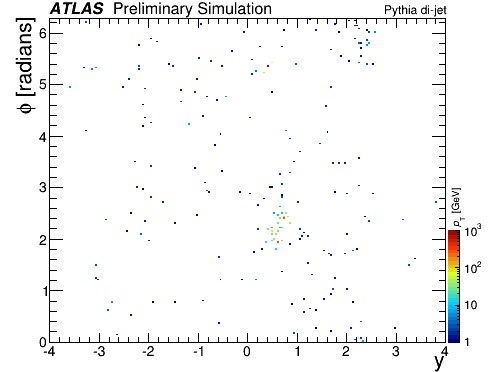 [eps] |
| The active area of anti-kt (R=1.0) jets built from topological clusters. Color indicates the pT of reconstructed jets and of calorimeter topological clusters. Jets are calibrated at constituent level (no JES applied). Energetic jets from the hard scatter (in red) have a circular shape. Close-by softer jets exhibit more irregular boundaries. ATLAS simulation of a di-jet event (Pythia8). Sequence illustrating jet trimming, image 2 out of 9. |  [eps] |
| The active area of anti-kt (R=1.0) jets built from topological clusters. Color indicates the pT of reconstructed jets and of calorimeter topological clusters (jets have no JES applied). Jets with transverse momentum below 20 GeV are omitted. ATLAS simulation of a di-jet event (Pythia8). Sequence illustrating jet trimming, image 3 out of 9. |  [eps] |
| Anti-kt (R=1.0) jets built from topological clusters. The border of the jet area is shown for clarity. Color indicates the pT of reconstructed jets and of calorimeter topological clusters (jets have no JES applied). Jets with transverse momentum below 20 GeV are omitted. ATLAS simulation of a di-jet event (Pythia8). Sequence illustrating jet trimming, image 4 out of 9. |  [eps] |
| Anti-kt (R=1.0) jets and all their respective subjets (in gray). Subjets are reconstructed from the topological clusters of the parent jet with the kt algorithm and Rsub=0.3. Color indicates the pT of reconstructed jets and of calorimeter topological clusters (jets have no JES applied). Jets with transverse momentum below 20 GeV are omitted. ATLAS simulation of a di-jet event (Pythia8). Sequence illustrating jet trimming, image 5 out of 9. |  [eps] |
| Anti-kt (R=1.0) jets and kt (Rsub=0.3) subjets (inclusive). The color of jets, subjets and of calorimeter topological clusters indicates their pT (jets and subjets have no JES applied). Note the upper energetic jet with a hard subjet in its core surrounded by softer subjets; this relates to the energy density pattern of QCD radiation inside a QCD jet. Jets with transverse momentum below 20 GeV are omitted. ATLAS simulation of a di-jet event (Pythia8). Sequence illustrating jet trimming, image 6 out of 9. |  [eps] |
| Anti-kt (R=1.0) jets and kt (Rsub=0.3) subjets (inclusive). The color of jets and of calorimeter topological clusters indicates their absolute pT . Subjets are plot with a second color scale which indicates the subjet’s pT relative to its parent jet pT (jets and subjets have no JES applied). Jets with transverse momentum below 20 GeV are omitted. ATLAS simulation of a di-jet event (Pythia8). Sequence illustrating jet trimming, image 7 out of 9. |  [eps] |
| Anti-kt (R=1.0) jets and kt (Rsub=0.3) subjets. Jet Trimming: subjets are removed if their pT is less than fcut × pjet (with fcut = 0.05). The color of subjets indicates the subjet’s pT relative to its T parent jet pT . The color of jets and of calorimeter topological clusters indicates their pT (jets and subjets have no JES applied). Jets with transverse momentum below 20 GeV are omitted. ATLAS simulation of a di-jet event (Pythia8). Sequence illustrating jet trimming, image 8 out of 9. |  [eps] |
| Anti-kt (R=1.0) calorimeter jets. kt (Rsub=0.3) subjets kept after trimming (with fcut = 0.05) are shown in light gray. The color of jets and of calorimeter topological clusters indicates their pT (jets and subjets have no JES applied). Jets with transverse momentum below 20 GeV are omitted. ATLAS simulation of a di-jet event (Pythia8). Sequence illustrating jet trimming, image 9 out of 9. | 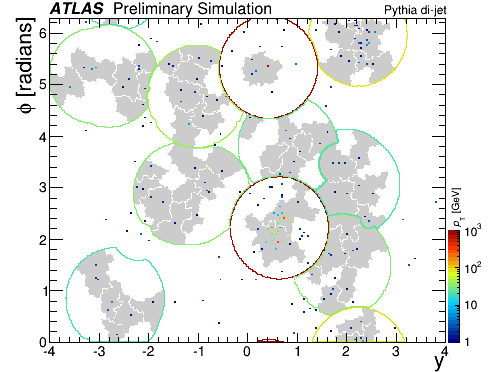 [eps] |
Reconstruction with Pile-up
| Multijet event with no pileup up. Topological clusters are shown as black dots. Anti-kt R=0.4 jets with pT > 20 GeV and jet area-based pileup corrections applied are shown in colors associated to their pT. |  [eps] |
| Multijet event in the presence of 80 additional interactions. Topological clusters are shown as black dots. Anti-kt R=0.4 jets with pT > 20 GeV and jet area-based pileup corrections applied are shown in colors associated with their pT . The topocluster sigma noise value is 40. The increase in the number of clusters is due to the additional energy deposited by pileup particles. |  [eps] |
| Multijet event in the presence of 80 additional interactions. Topological clusters are shown as black dots. Anti-kt R=0.4 jets with pT > 20 GeV and jet area-based pileup corrections applied are shown in colors associated to their pT . The topocluster sigma noise value is 80. The higher sigma noise value provides a partial reduction of clusters initiated by pileup energy depositions. |  [eps] |
Boosted Ws
| Anti-kt (R=1.0) calorimeter jets from a W′ → WZ simulated event (ATLAS simulation, Pythia8, W′ produced off-shell with mW′ = 283 GeV). The W boson has pT = 100 GeV. The W′ boson and its hard decaying particles (up to grandchildren) from the Monte Carlo shower are indicated by their labels. In this non-boosted regime decaying particles can be separated across the detector (see s and c quarks from W ). Heavy bosons and their decay products may not be aligned due to photon/gluon emissions not represented here. The color of jets and of calorimeter topological clusters indicates their pT (jets and subjets have no JES applied). Hardest jets have a circular shape whereas close-by softer jets exhibit more irregular boundaries. Jets with pT < 20 GeV are omitted. This plot is accompanied by others showing the same event reconstructed with kt and C/A algorithms, and with subjets. |  [eps] |
| Cambridge-Aachen (R=1.0) calorimeter jets from a W′ → WZ simulated event (ATLAS simulation,Pythia8, W′ produced off-shell with mW′ =283GeV).The W boson has pT = 100 GeV. The W′ boson and its hard decaying particles (up to grandchildren) from the Monte Carlo shower are indicated by their labels. In this non-boosted regime decaying particles can be separated across the detector (see s and c ̄ quarks from W ). Heavy bosons and their decay products may not be aligned due to photon/gluon emissions not represented here. The color of jets and of calorimeter topological clusters indicates their pT (jets and subjets have no JES applied). Jets with pT < 20 GeV are omitted. This plot is accompanied by others showing the same event reconstructed with anti-kt and kt algorithms, and with subjets. |  [eps] |
| Kt (R=1.0) calorimeter jets from a W′ → WZ simulated event (ATLAS simulation, Pythia8, W′ produced off-shell with mW′ = 283 GeV). The W boson has pT = 100 GeV. The W′ boson and its hard decaying particles (up to grandchildren) from the Monte Carlo shower are indicated by their labels. In this non-boosted regime decaying particles can be separated across the detector (see s and c ̄ quarks from W ). Heavy bosons and their decay products may not be aligned due to photon/gluon emissions not represented here. The color of jets and of calorimeter topological clusters indicates their pT (jets and subjets have no JES applied). Jets with pT < 20 GeV are omitted. This plot is accompanied by others showing the same event reconstructed with anti-kt and C/A algorithms, and with subjets. |  [eps] |
| Trimmed (fcut = 0.05) anti-kt (R=1.0) calorimeter jets from a W′ → WZ simulated event (ATLAS simulation, Pythia8, W ′ produced off-shell with mW ′ = 283 GeV). Subjets are built with kt algorithm and Rsub=0.3. The W boson has pT = 100 GeV. In this non-boosted regime decaying particles can be separated across the detector (see s and c ̄ quarks from W). The W′ boson and its hard decaying particles (up to grandchildren) from the Monte Carlo shower are indicated by their labels. The color of jets and of calorimeter topological clusters indicates their pT (jets and subjets have no JES applied). Subjet color indicates its pT relative to the parent jet pT . Hardest jets have a circular shape whereas close-by softer jets exhibit more irregular boundaries. Jets with pT < 20 GeV are omitted. This plot is accompanied by others showing the same event reconstructed with kt and C/A algorithms,without subjets. |  [eps] |
| Trimmed (fcut = 0.05) cambridge-aachen (R=1.0) calorimeter jets from a W ′ → WZ simulated event (ATLAS simulation, Pythia8, W ′ produced off-shell with mW ′ = 283 GeV). Subjets are built with kt algorithm and Rsub=0.3. The W boson has pT = 100 GeV. In this non-boosted regime decaying particles can be separated across the detector (see s and c ̄ quarks from W). The W′ boson and its hard decaying particles (up to grandchildren) from the Monte Carlo shower are indicated by their labels. Heavy bosons and their decay products may not be aligned due to photon/gluon emissions not represented here. The color of jets and of calorimeter topological clusters indicates their pT (jets and subjets have no JES applied). Subjet color indicates its pT relative to the parent jet pT . Jets with pT < 20 GeV are omitted. This plot is accompanied by others showing the same event reconstructed with anti-kt and kt algorithms. |  [eps] |
| Trimmed (fcut = 0.05) kt (R=1.0) calorimeter jets from a W′ → WZ simulated event (ATLAS simulation, Pythia8, W ′ produced off-shell with mW ′ = 283 GeV). Subjets are built with kt algorithm and Rsub=0.3. The W boson has pT = 100 GeV. In this non-boosted regime decaying particles can be separated across the detector (see s and c ̄ quarks from W). The W′ boson and its hard decaying particles (up to grandchildren) from the Monte Carlo shower are indicated by their labels. The color of jets and of calorimeter topological clusters indicates their pT (jets and subjets have no JES applied). Subjet color indicates its pT relative to the parent jet pT . Jets with pT < 20 GeV are omitted. This plot is accompanied by others showing the same event reconstructed with anti-kt and C/A algorithms, without subjets. |  [eps] |
| Anti-kt (R=1.0) calorimeter jets from a W′ → WZ simulated event (ATLAS simulation, Pythia8, W′ produced off-shell with mW′ = 628 GeV). The W boson has pT = 300 GeV. The W ′ boson and its hard decaying particles (up to grandchildren) from the Monte Carlo shower are indicated by their labels. In this regime decaying particles may be collected in the same large-R jet. The color of jets and of calorimeter topological clusters indicates their pT (jets and subjets have no JES applied). Hardest jets have a circular shape whereas close-by softer jets exhibit more irregular boundaries. Jets with pT < 20 GeV are omitted. This plot is accompanied by others showing the same event reconstructed with kt and C/A algorithms, and with subjets. | 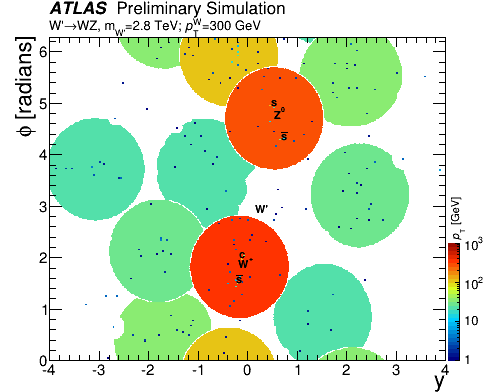 [eps] |
| Cambridge-Aachen (R=1.0) calorimeter jets from a W′ → WZ simulated event (ATLAS simulation,Pythia8, W′ produced off-shell with mW′ =628GeV).The W boson has pT = 300 GeV. The W′ boson and its hard decaying particles (up to grandchildren) from the Monte Carlo shower are indicated by their labels. In this regime decaying particles may be collected in the same large-R jet. The color of jets and of calorimeter topological clusters indicates their pT (jets and subjets have no JES applied). Jets with pT < 20 GeV are omitted. This plot is accompanied by others showing the same event reconstructed with anti-kt and kt algorithms, and with subjets. | 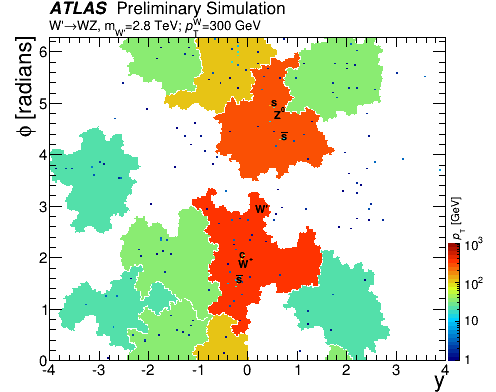 [eps] |
| Kt (R=1.0) calorimeter jets from a W′ → WZ simulated event (ATLAS simulation, Pythia8, W′ produced off-shell with mW′ = 628 GeV). The W boson has pT = 300 GeV. The W ′ boson and its hard decaying particles (up to grandchildren) from the Monte Carlo shower are indicated by their labels. In this regime decaying particles may be collected in the same large-R jet. The color of jets and of calorimeter topological clusters indicates their pT (jets and subjets have no JES applied). Jets with pT < 20 GeV are omitted. This plot is accompanied by others showing the same event reconstructed with anti-kt and C/A algorithms, and with subjets. |  [eps] |
| Trimmed (fcut = 0.05) anti-kt (R=1.0) calorimeter jets from a W′ → WZ simulated event (ATLAS simulation, Pythia8, W ′ produced off-shell with mW ′ = 628 GeV). Subjets are built with kt algorithm and Rsub=0.3. The W boson has pT = 300 GeV. In this regime decaying particles may be collected in the same large-R jet, in separated subjets. The W′ boson and its hard decaying particles (up to grandchildren) from the Monte Carlo shower are indicated by their labels. The color of jets and of calorimeter topological clusters indicates their pT (jets and subjets have no JES applied). Subjet color indicates its pT relative to the parent jet pT . Hardest jets have a circular shape whereas close-by softer jets exhibit more irregular boundaries. Jets with pT < 20 GeV are omitted. This plot is accompanied by others showing the same event reconstructed with kt and C/A algorithms, without subjets. |  [eps] |
| Trimmed (fcut = 0.05) cambridge-aachen (R=1.0) calorimeter jets from a W ′ → WZ simulated event (ATLAS simulation, Pythia8, W′ produced off-shell with mW′ = 628 GeV). Subjets are built with kt algorithm and Rsub=0.3. The W boson has pT = 300 GeV. In this regime decaying particles may be collected in the same large-R jet, in separated subjets. The W′ boson and its hard decaying particles (up to grandchildren) from the Monte Carlo shower are indicated by their labels. The color of jets and of calorimeter topological clusters indicates their pT (jets and subjets have no JES applied). Subjet color indicates its pT relative to the parent jet pT . Jets with pT < 20 GeV are omitted. This plot is accompanied by others showing the same event reconstructed with anti-kt and kt algorithms, without subjets. |  [eps] |
| Trimmed (fcut = 0.05) kt (R=1.0) calorimeter jets from a W′ → WZ simulated event (ATLAS simulation, Pythia8, W ′ produced off-shell with mW ′ = 628 GeV). Subjets are built with kt algorithm and Rsub=0.3. The W boson has pT = 300 GeV. In this regime decaying particles may be collected in the same large-R jet, in separated subjets. The W′ boson and its hard decaying particles (up to grandchildren) from the Monte Carlo shower are indicated by their labels. The color of jets and of calorimeter topological clusters indicates their pT (jets and subjets have no JES applied). Subjet color indicates its pT relative to the parent jet pT . Jets with pT < 20 GeV are omitted. This plot is accompanied by others showing the same event reconstructed with anti-kt and C/A algorithms, without subjets. |  [eps] |
| Anti-kt (R=1.0) calorimeter jets from a W′ → WZ simulated event (ATLAS simulation, Pythia8, W′ produced off-shell with mW′ = 1.58 TeV). The W boson has pT = 800 GeV. The W′ boson and its hard decaying particles (up to grandchildren) from the Monte Carlo shower are indicated by their labels. In this regime decaying particles may be collected in the same large-R jet. Jet color represents its pT . Hardest jets have a circular shape whereas close-by softer jets exhibit more irregular boundaries. Jets with pT < 20 GeV are omitted. This plot is accompanied by others showing the same event reconstructed with kt and C/A algorithms, and with subjets. |  [eps] |
| Cambridge-Aachen (R=1.0) calorimeter jets from a W′ → WZ simulated event (ATLAS simulation,Pythia8,W′ produced off-shell with mW′ =1.58TeV).The W boson has pT = 800 GeV. The W′ boson and its hard decaying particles (up to grandchildren) from the Monte Carlo shower are indicated by their labels. In this regime decaying particles may be collected in the same large-R jet. The color of jets and of calorimeter topological clusters indicates their pT (jets and subjets have no JES applied). Jets with pT < 20 GeV are omitted. This plot is accompanied by others showing the same event reconstructed with anti-kt and kt algorithms, and with subjets. | 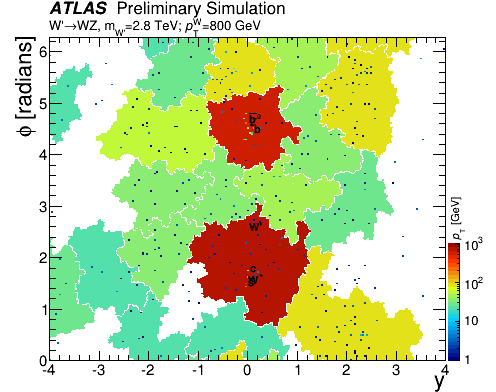 [eps] |
| Kt (R=1.0) calorimeter jets from a W′ → WZ simulated event (ATLAS simulation, Pythia8, W′ produced off-shell with mW ′ = 1.58 TeV). The W boson has pT = 800 GeV. The W ′ boson and its hard decaying particles (up to grandchildren) from the Monte Carlo shower are indicated by their labels. In this regime decaying particles may be collected in the same large-R jet. The color of jets and of calorimeter topological clusters indicates their pT (jets and subjets have no JES applied). Jets with pT < 20 GeV are omitted. This plot is accompanied by others showing the same event reconstructed with anti-kt and C/A algorithms, and with subjets. |  [eps] |
| Trimmed (fcut = 0.05) anti-kt (R=1.0) calorimeter jets from a W′ → WZ simulated event (ATLAS simulation, Pythia8, W′ produced off-shell with mW ′ = 1.58 TeV). Subjets are built with kt algorithm and Rsub=0.3. The W boson has pT = 800 GeV. In this regime decaying particles may be collected in the same large-R jet. Partons may not be resolved into separated subjets. The W′ boson and its hard decaying particles (up to grandchildren) from the Monte Carlo shower are indicated by their labels. The color of jets and of calorimeter topological clusters indicates their pT (jets and subjets have no JES applied). Subjet color indicates its pT relative to the parent jet pT . Hardest jets have a circular shape whereas close-by softer jets exhibit more irregular boundaries. Jets with pT < 20 GeV are omitted. This plot is accompanied by others showing the same event reconstructed with kt and C/A algorithms,without subjets. |  [eps] |
| Trimmed (fcut = 0.05) cambridge-aachen (R=1.0) calorimeter jets from a W ′ → WZ simulated event (ATLAS simulation, Pythia8, W′ produced off-shell with mW′ = 1.58 TeV). Subjets are built with kt algorithm and Rsub=0.3. The W boson has pT = 800 GeV. In this regime decaying particles may be collected in the same large-R jet. Partons may not be resolved into separated subjets. The W′ boson and its hard decaying particles (up to grandchildren) from the Monte Carlo shower are indicated by their labels. The color of jets and of calorimeter topological clusters indicates their pT (jets and subjets have no JES applied). Subjet color indicates its pT relative to the parent jet pT . Jets with pT < 20 GeV are omitted. This plot is accompanied by others showing the same event reconstructed with anti-kt and kt algorithms, without subjets. | 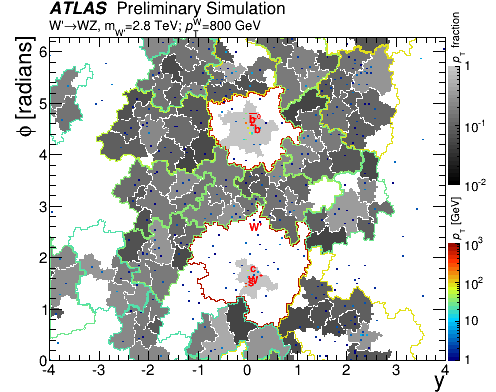 [eps] |
| Trimmed (fcut = 0.05) kt (R=1.0) calorimeter jets from a W′ → WZ simulated event (ATLAS simulation, Pythia8, W′ produced off-shell with mW′ = 1.58 TeV). Subjets are built with kt algorithm and Rsub=0.3. The W boson has pT = 800 GeV. In this regime decaying particles may be collected in the same large-R jet. Partons may not be resolved into separated subjets. The W′ boson and its hard decaying particles (up to grandchildren) from the Monte Carlo shower are indicated by their labels. The color of jets and of calorimeter topological clusters indicates their pT (jets and subjets have no JES applied). Subjet color indicates its pT relative to the parent jet pT . Jets with pT < 20 GeV are omitted. This plot is accompanied by others showing the same event reconstructed with anti-kt and C/A algorithms, without subjets. | 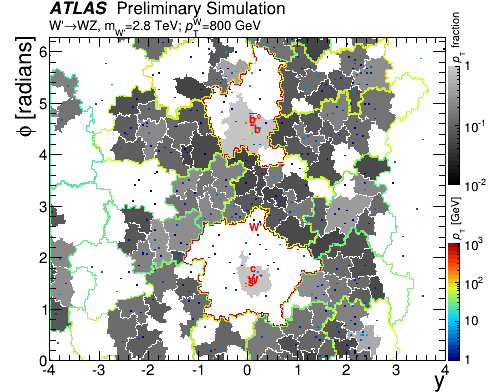 [eps] |
Boosted Tops
| Anti-kt (R=0.4) calorimeter jets from a ttbar simulated event (ATLAS simulation, Powheg+Pythia). The top quark has pT = 100 GeV. The top quark and its hard decaying particles (up to grandchildren) from the Monte Carlo shower are indicated by their labels. In this non-boosted regime decaying particles can be separated across the detector, note: d and u quarks from W− decay. W boson and b quark may not be aligned with the top quark due to photon/gluon emissions not represented here. The color of jets and of calorimeter topological clusters indicates their pT (jets and subjets have no JES applied). Jets with pT < 20 GeV are omitted. This plot is accompanied by other showing the same event reconstructed with R=1.0. | 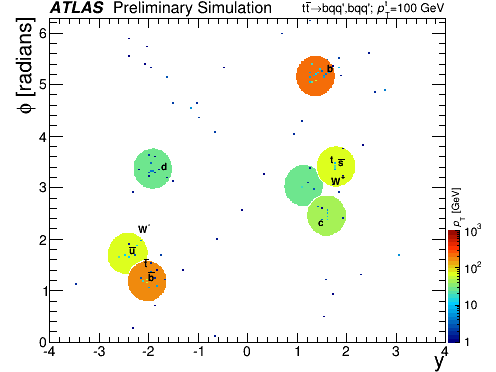 [eps] |
| Anti-kt (R=1.0) calorimeter jets from a ttbar simulated event (ATLAS simulation, Powheg+Pythia). The top quark has pT = 100 GeV. Subjets are built with kt algorithm and Rsub=0.3. The top quark and its hard decaying particles (up to grandchildren) from the Monte Carlo shower are indicated by their labels. In this non-boosted regime decaying particles can be separated across the detector, note: b quark and W + boson from top decay, and d and u ̄ quarks from W − decay. W boson and b quark may not be aligned with the top quark due to photon/gluon emissions not represented here. The color of jets and of calorimeter topological clusters indicates their pT (jets and subjets have no JES applied). Subjet color indicates its pT relative to the parent jet pT . Jets with pT < 20 GeV are omitted. This plot is accompanied by other showing the same event reconstructed with R=0.4. |  [eps] |
| Anti-kt (R=0.4) calorimeter jets from a ttbar simulated event (ATLAS simulation, Powheg+Pythia). The top quark has pT = 300 GeV. The top quark and its hard decaying particles (up to grandchildren) from the Monte Carlo shower are indicated by their labels. In this energy regime decaying particles from heavy quark can produce close-by (resolved) jets. The color of jets and of calorimeter topological clusters indicates their pT (jets and subjets have no JES applied). Jets with pT < 20 GeV are omitted. This plot is accompanied by other showing the same event reconstructed with R=1.0. |  [eps] |
| Anti-kt (R=1.0) calorimeter jets from a ttbar simulated event (ATLAS simulation, Powheg+Pythia). The top quark has pT = 300 GeV. Subjets are built with kt algorithm and Rsub=0.3. The top quark and its hard decaying particles (up to grandchildren) from the Monte Carlo shower are indicated by their labels. In this energy regime decaying particles from heavy quark can be distinguished as different subjets. The color of jets and of calorimeter topological clusters indicates their pT (jets and subjets have no JES applied). Subjet color indicates its pT relative to theparentjetpT.JetswithpT <20GeVareomitted.Thisplotisaccompaniedbyothershowing the same event reconstructed with R=0.4. |  [eps] |
| Anti-kt (R=0.4) calorimeter jets from a ttbar simulated event (ATLAS simulation, Powheg+Pythia). The top quark has pT = 800 GeV. The top quark and its hard decaying particles (up to grandchildren) from the Monte Carlo shower are indicated by their labels. In this boosted regime decaying particles from heavy quark may not be resolved as separated jets. The color of jets and of calorimeter topological clusters indicates their pT (jets and subjets have no JES applied). Jets with pT < 20 GeV are omitted. This plot is accompanied by other showing the same event reconstructed with R=1.0. |  [eps] |
| Anti-kt (R=1.0) calorimeter jets from a ttbar simulated event (ATLAS simulation, Powheg+Pythia). The top quark has pT = 800 GeV. Subjets are built with kt algorithm and Rsub=0.3. The top quark and its hard decaying particles (up to grandchildren) from the Monte Carlo shower are indicated by their labels. In this boosted regime several decaying particles from heavy quark decay may be contained in the same subjet. The color of jets and of calorimeter topological clusters indicates their pT (jets and subjets have no JES applied). Subjet color indicates its pT relative to the parent jet pT . Jets with pT < 20 GeV are omitted. This plot is accompanied by other showing the same event reconstructed with R=0.4. | 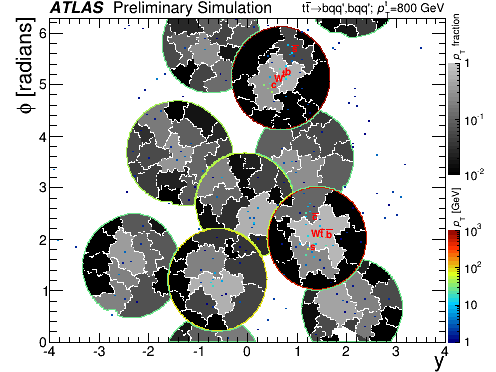 [eps] |
Boosted Higgs
| y Anti-kt (R=0.4) calorimeter jets from a H + Z simulated event (ATLAS simulation, Madgraph+Pythia8). The Higgs boson has pT = 100 GeV. The Higgs boson and its hard decaying particles from the Monte Carlo shower are indicated by their labels. In this non-boosted regime decaying particles can be separated across the detector: b and b ̄ quarks from Higgs decay can be resolved in separated small jets. bbbar pair and Higgs boson may not be aligned due to photon/gluon emissions not represented here. The color of jets and of calorimeter topological clusters indicates their pT (jets and subjets have no JES applied). Jets with pT < 20 GeV are omitted. This plot is accompanied by other showing the same event reconstructed with R=1.0. | 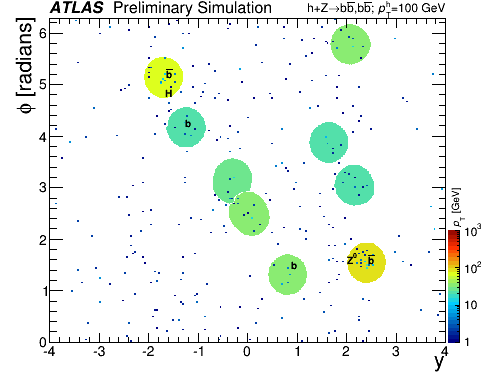 [eps] |
| Anti-kt (R=1.0) calorimeter jets from a H + Z simulated event (ATLAS simulation, Madgraph+Pythia8). Subjets are built with kt algorithm and Rsub=0.3. The Higgs boson has pT = 100 GeV. The Higgs boson and its hard decaying particles from the Monte Carlo shower are indicated by their labels. In this non-boosted regime decaying particles can be separated across the detector, but may be collected in the same large-R jet. bbbar pair and Higgs boson may not be aligned due to photon/gluon emissions not represented here. The color of jets and of calorimeter topological clusters indicates their pT (jets and subjets have no JES applied). Subjet color indicates its pT relative to the parent jet pT . Jets with pT < 20 GeV are omitted. This plot is accompanied by other showing the same event reconstructed with R=0.4. |  [eps] |
| Anti-kt (R=0.4) calorimeter jets from a H + Z simulated event (ATLAS simulation, Madgraph+Pythia8). The Higgs boson has pT = 300 GeV. The Higgs boson and its hard decaying particles from the Monte Carlo shower are indicated by their labels. In this energy regime jets from Higgs’ decaying particles can be close to each other. bbbar pair and Higgs boson may not be aligned due to photon/gluon emissions not represented here. The color of jets and of calorimeter topological clusters indicates their pT (jets and subjets have no JES applied). Jets with pT < 20 GeV are omitted. This plot is accompanied by other showing the same event reconstructed with R=1.0. | 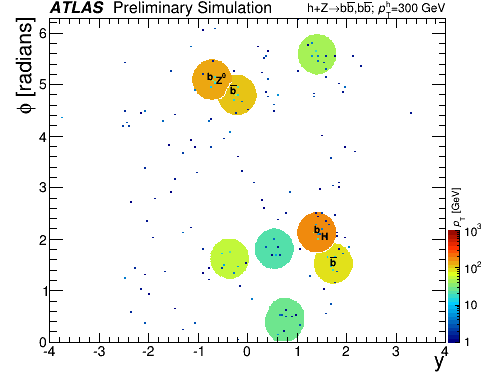 [eps] |
| Anti-kt (R=1.0) calorimeter jets from a H + Z simulated event (ATLAS simulation, Madgraph+Pythia8). Subjets are built with kt algorithm and Rsub=0.3. The Higgs boson has pT = 300 GeV. The Higgs boson and its hard decaying particles from the Monte Carlo shower are indicated by their labels. In this energy regime Higgs decay products may be resolved as separated subjets inside a large-R jet. bbbar pair and Higgs boson may not be aligned due to photon/gluon emissions not represented here. The color of jets and of calorimeter topological clusters indicates their pT (jets and subjets have no JES applied). Subjet color indicates its pT relative to the parent jet pT . Jets with pT < 20 GeV are omitted. This plot is accompanied by other showing the same event reconstructed with R=0.4. |  [eps] |
| Anti-kt (R=0.4) calorimeter jets from a H + Z simulated event (ATLAS simulation, Madgraph+Pythia8). The Higgs boson has pT = 800 GeV. The Higgs boson and its hard decaying particles from the Monte Carlo shower are indicated by their labels. In this boosted regime decaying particles can be unresolved by small-R jets. The color of jets and of calorimeter topological clusters indicates their pT (jets and subjets have no JES applied). Jets with pT < 20 GeV are omitted. This plot is accompanied by other showing the same event reconstructed with R=1.0. |  [eps] |
| Anti-kt (R=1.0) calorimeter jets from a H + Z simulated event (ATLAS simulation, Madgraph+Pythia8). Subjets are built with kt algorithm and Rsub=0.3. The Higgs boson has pT = 800 GeV. The Higgs boson and its hard decaying particles from the Monte Carlo shower are indicated by their labels. In this energy regime Higgs decay products may be contained in the same subjet inside a large-R jet. The color of jets and of calorimeter topological clusters indicates their pT (jets and subjets have no JES applied). Subjet color indicates its pT relative to the parent jet pT.Jets with pT <20 GeV are omitted.This plot is accompanied by other showing the same event reconstructed with R=0.4. |  [eps] |
Major updates:
-- DavidLopezMateos - 17 Aug 2014 Responsible: DavidLopezMateos
Subject: public
Topic revision: r4 - 2015-02-09 - DavidLopezMateos
or Ideas, requests, problems regarding TWiki? use Discourse or Send feedback
